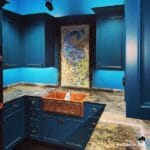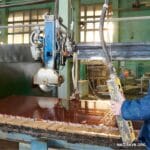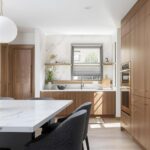When you picture a dream kitchen, what do you see? Maybe a big island in the center, cabinets with clean lines and countertop that look like that is made just for your space. One feature that has been catching the eye of homeowners, and designers is the waterfall edge countertop. Its sleek, modern, and instantly changes the feel of a kitchen from ordinary to designer-level.
But what exactly is a waterfall edge, why is it so popular and is it the right choice for you? Let’s break it down in a way thats simple and practical so by the end of this guide, you’ll know if this trend is a good fit for your home.
What Makes a Countertop “Waterfall”?
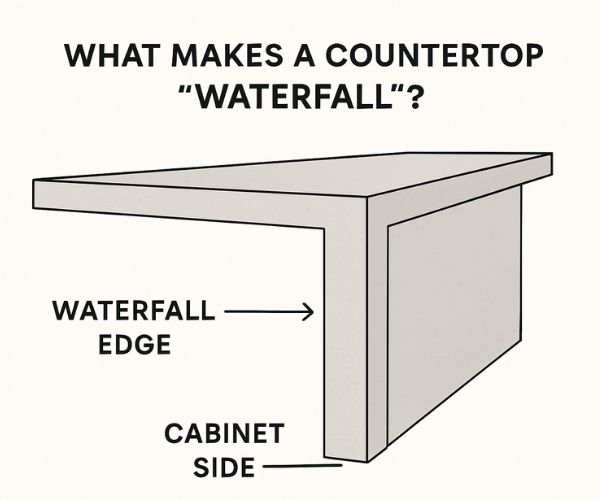
In a traditional kitchen, countertops stop at the cabinet line. They sit on top, flat and functional. A waterfall edge takes that idea a step further. Instead of stopping at the edge the countertop continues down the side of the cabinets flowing vertically until it touches the floor.
The effect is seamless, almost like the surface is “pouring” down the sides of your island or peninsula—hence the name “waterfall.” It’s not just a countertop anymore; it becomes a design feature in its own right.
Why People Love Waterfall Edge Countertops
You don’t need to be an interior designer, to see why this look has become so popular. Here are a few reason why homeowners choose it:
- It feels modern and polished: The clean, continuous lines add a touch of luxury, even a simple kitchen can feel elevated with this feature.
- It shows off beautiful materials: If you have chosen marble with bold veining, or quartz with striking pattern waterfall edge, lets you enjoy it from more than one angle.
- It protects your cabinets: Those vertical slabs aren’t just pretty—they guard the sides of your island from kicks, bumps, and spills.
- It makes a statement: In many homes, the kitchen island is the first thing guests notice. A waterfall edge guarantees a “wow” moment.
See More: Sparkling White Quartz
Best Materials for a Waterfall Edge
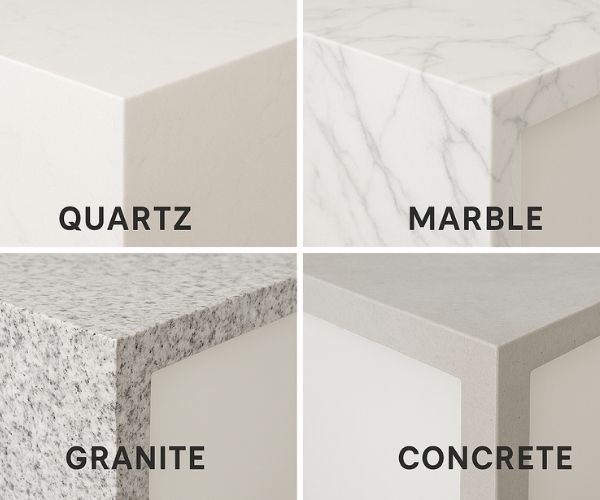
Not every countertop material works well for this style. The design needs something sturdy enough to run vertically and beautiful enough to showcase. Here are the most popular options:
Quartz: Probably the most common choice because it is durable, low-maintenance, and available in countless colors and patterns.
Marble: Classic and elegant, the veining looks stunning when it flows over the edge, though it does require more care to avoid stains.
Granite: Each slab is unique, which makes your island one of a kind with strong and long-lasting.
Quartzite: Natural stone looks like marble but is harder, and more resistant to scratches.
Concrete: Is a good option for modern homes or commercial spaces, because it can be customized with pigments and finishes.
Solid surfaces (Coria): Excellent for a uniform, seamless appearance without any visible seams.
Where Can You Use it?
Most people think of waterfall countertops in the kitchen but they are not limited to that space. Here are some creative uses:
- Kitchen islands – The most common spot, and for good reason. It instantly makes the island the star of the room.
- Peninsulas – If you don’t have an island, a peninsula with a waterfall edge still creates that modern feel.
- Bathrooms – Imagine a marble vanity that flows down both sides, fashionable and practical.
- Workspaces or bars – Laundry rooms, home offices, and even bar areas can use this design.
See More: Bianco Superiore Quartzite
Pros and Cons You Should Know
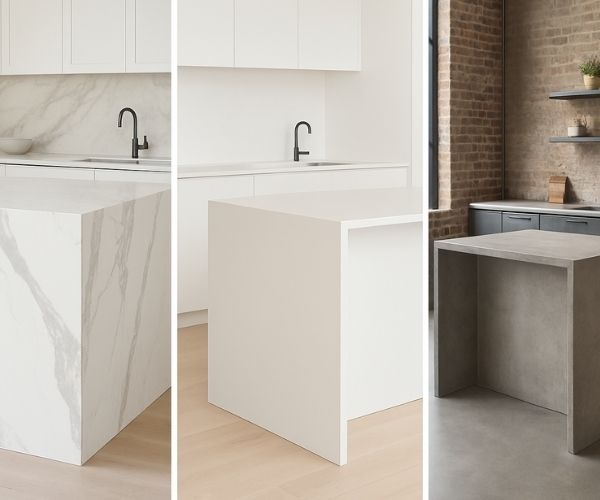
Like any design decision there are benefits and drawbacks to waterfall countertops.
Pros:
- Adds a striking, high-end look.
- Protects cabinetry sides from damage.
- Highlights, your countertop material.
- Enhances appeal, and visual value.
Cons:
- Costs is high because, of labor and additional materials.
- May look too modern in a rustic, or traditional kitchen.
- Large slabs might need seams, which some people find distracting.
- Reduces options for cabinet-side storage or outlets.
How Much Do They Cost?
This is the part most homeowners want to know upfront, Because waterfall edges use more material and require precise installation, they do cost more than a standard countertop.
Here’s a ballpark range by material:
- Quartz: $70–$120 per square foot
- Marble: $90–$200 per square foot
- Granite: $80–$150 per square foot
- Quartzite: $90–$180 per square foot
- Concrete: $60–$100 per square foot
On average, expect to spend between $2,000 and $6,000 for a waterfall island. High-end stone can push the price higher, especially for larger kitchens.
What Installation Looks Like
Installing a waterfall edge countertop is not a casual DIY weekend project. It needs professionals who know how to cut and seam the slabs precisely.
The process usually includes:
- Templating: Finding the precise measurements, of your area.
- Cutting: Stone is cut by the fabricator at exact, 45-degree angles.
- Seaming: To make the joint appear to be one continuous piece, the edges are polished and glued.
- Installation: After carefully fitting the slab over the cabinets it is fastened in position.
The difference between a great installation and a poor one often comes down to how well those seams are matched.
Care and Maintenance
Day-to-day upkeep is simple, but it depends on the material you choose.
- Wipe down daily with mild soap and water.
- Avoid harsh cleaners like bleach or ammonia.
- Seal natural stone (granite, marble, quartzite) once a year. Quartz usually doesn’t need sealing.
- Use trivets and cutting boards to prevent heat damage or scratches.
With the right care your waterfall countertop can last for decades, and still look as good as new.
Design Ideas to Inspire You
Here are some design guidelines to help you visualize, how this would appear in your own house:
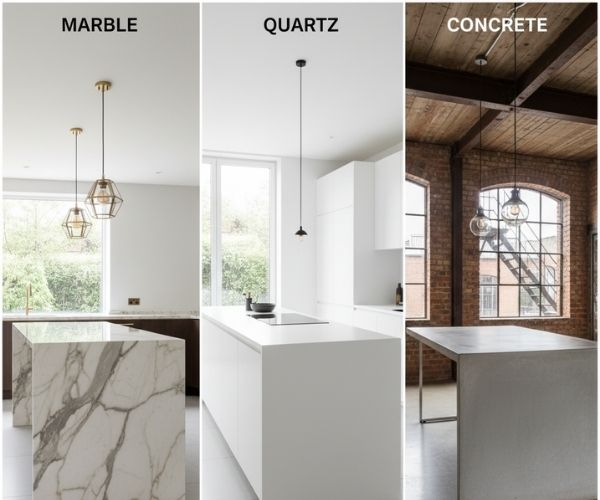
- Bold veins in marble: Allow the stone organic movement to flow over the edge, without interruption.
- White quartz minimalist: Simple, clear and classic.
- Light cabinets with dark granite: The island stands out due, to the stark contrast.
- Two-tone kitchens: Pair a waterfall edge with cabinets in a different color, or material for a layered look.
- Concrete in a loft: Fits right in with exposed beams and industrial lighting.
Is It Right for You?
Should you go for a waterfall countertop edge?
Select it if:
- You desire an innovative kitchen, that makes a statement.
- You are spending money on something, that is worth flaunting.
- You prioritize long-term value, and durability.
But skip it if:
- You are on a tight budget.
- You prefer a traditional or farmhouse look.
- You need cabinet sides for outlets, shelves or storage.

